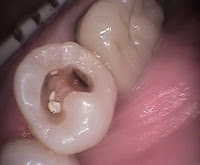Silver Fillings – Don’t They Last Forever?
by
Hans Schleicher, DDS
Ok, so those old silver fillings that were done when you were a teenager last forever right? Unfortunately that is not the case. Silver fillings are actually silver, mercury, tin, zinc, lead, and copper. When they are all mixed together they form the dental silver amalgam material that has been used for years in dentistry. Over the time this mix of metals begins to corrode or rust, and with expansion and shrinking from temperature changes these metal fillings begin to lose the tight seal that keeps bacteria from entering the space between the filling and the tooth.
Studies show that the average life expectancy of a silver filling is between 8 and 12 years. The problem is when do we replace these old fillings? The answer is: as soon as you can see that the seal is starting to fail. This has to be done with direct vision by the dentist because an x-ray is not going to show the decay until it is UNDER the filling – and that’s too late – way more damage has been done by then.
Here are some examples of fillings that are 10 years old showing the how the filling looks and then, what we found under the fillings after we removed all the filling – we then stopped and took another picture to show the decay and damage going on silently under these fillings.
Filling looks pretty good at first. Look at the decay under the filling!
New composite resin filling in place
In over twenty five years of practice, I have never taken out an old silver/mercury filling without finding decayed tooth underneath.
Another normal looking filling Decay found underneath!
Final composite filling in place
So now you know why your dentist may recommend replacing those old silver/mercury fillings – the sooner the better - before more tooth structure is lost, and what could have been fixed with a larger filling ends up needing a crown and maybe a root canal. Early diagnosis and treatment is the key.






The output of mercury can be intensified by the number of fillings and other
ReplyDeleteactivities, such as chewing, teeth-grinding, and the consumption of hot liquids.
Mercury is also known to be released during
the placement, replacement, and removal of dental mercury amalgam fillings. Click here to know more about our services.
I have lots of silver fillings and had no problems if it was a massive danger the UK government would stop it.
ReplyDelete